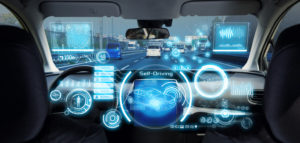What is the Future of Driverless Vehicles? — Trains, Planes and Automobiles

Cockpit of futuristic autonomous car.
Safety First for Automated Driving (SaFAD), a 146-page whitepaper authored by 11 companies from both the automobile and technology industries, has been published.
Because the document is the first of its kind, it already has made history in the future of driverless vehicles. Aptiv, Audi, Baidu, BMW, Continental, Daimler, Fiat Chrysler, Here, Infineon, Intel and Volkswagen partnered on the project, the purpose of which is to highlight safety by design and verification and validation (V&V).
“There is already a vast array of publications focusing on only specific subtopics of automated driving,” the whitepaper states. “In contrast, this publication promotes a comprehensive approach to safety relevant topics of automated driving and is based on the input of OEMs, tiered suppliers and key technology providers. The objective of this publication is to systematically break down safety principles into safety by design capabilities, elements and architectures and then to summarize the V&V methods in order to demonstrate the positive risk balance.”
Driverless vehicles are a certainty, and the race is on to get the rubber to the road. Honda, Tesla and many other manufacturers have been developing prototypes of cars and trucks at a furious pace because there are millions, if not billions, of dollars to be made. But the product they put on the pavement better be as close to perfect as possible.
“Automated driving will improve performance in most situations compared to that of human drivers,” the whitepaper states. “However, it will not completely eliminate the risk of accidents or crashes. The goal of this publication is to present a generic approach for tackling the risks introduced by automated vehicles. While this common generic approach should be interpreted as a baseline for safe automated driving, it does not define a specific product that is complete and safe.”
The National Highway Traffic Safety Administration reports that human error causes 94 percent of car crashes in the United States. The logic goes that replacing drivers with computers will lower that statistic and therefore save lives and limbs and lots of money. The challenge is in achieving positive risk balance.
“The purpose of this publication is to highlight safety and security-relevant aspects of developing, producing, operating and maintaining automated driving vehicles; the combination of which lead to a safe product on the road,” the whitepaper states. “The aspects brought forward should contribute toward a foundation for the safety of automated driving vehicles. The consortium partners of this publication share the common goal of their automated driving vehicles being better than the average human driver during automated guidance and slightly before or after transitioning to human guidance within the same ODD in terms of avoiding or mitigating related hazards with elevated severity, e.g. collisions or roadway departure crashes. At the same time, a slightly negative safety balance of the automated driving system in rare improbable scenarios may still be acceptable, providing a positive risk balance is maintained across all situations.”
ODD stands for operational design domain. It is intended to mean: “As soon as system limits that restrict the safe functionality of the automated system are recognized, the system shall react to compensate or shall issue a driver takeover request with a sufficient time frame for the takeover,” the whitepaper states. “The automated driving system shall take into account situations that can typically be expected in the ODD and address possible risks.”
The chassis of the whitepaper is a set of 12 underlying principles – safe operation, ODD, vehicle operator-initiated handover, security, user responsibility, vehicle-initiated handover, interdependency between the vehicle operator and the automated driving system, safety assessment, data recording, passive safety, behavior in traffic and safe layer.
“Based on the twelve principles for achieving the positive risk balance, this publication devises a possible overall structure for the safety by design and the validation and verification process,” the whitepaper states. “This publication establishes traceability between the top-level twelve principles and specific existing elements by introducing capabilities of automated driving based on the three dependability domains of safety by the intended functionality, functional safety, and cyber security.”
An article on the aftermarketNews Web site titled “Automotive, Mobility Leaders Publish Framework For Safe Automated Driving Systems” says the whitepaper has promise and potential and “combines expertise from automakers, suppliers and tech companies to help direct development of safe automated vehicles.”
“Interest in and development of automated-driving technology has grown at a dramatic rate over the past several years, fueled by the goal of reducing fatalities related to vehicle crashes, improvement of traffic flow and the introduction of new mobility concepts,” according to the article. “This rapid growth brings a wide range of development methodologies from established companies and the growing roster of new enterprises. With the publication of “Safety First for Automated Driving,” authors and experts from each of the participating partners will present the group’s work at industry and technology conferences internationally over the next several months.”
How the law will develop with the potential of poor design, software glitches and the potential failures inherent in the interface between driver and computer, is anyone’s best guess. We will continue to follow the development of the technology with thoughts about the legal implications for sometime to come.
Share This


